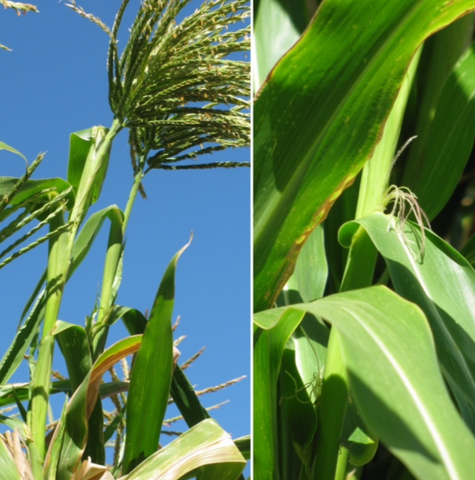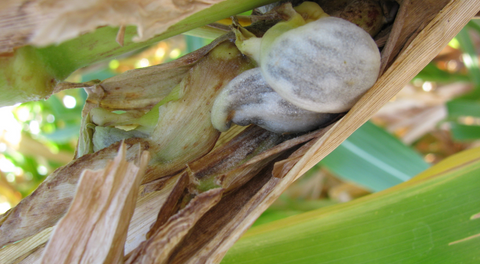
By Nancy Reid, NS/S Retail Associate.
There is so much to learn about the mysterious teosinte that I was stumped when asked to create a report on growing it, so I’ll simply share what I’ve read and observed while studying the plants growing at the retail store in mid-town Tucson, Arizona.
Archaeologists, botanists, and geneticists generally agree that teosinte (Zea mays parvaglumis) is the wild ancestor to domesticated corn. Known as Teocintle, el grano de los dioses (grain of the gods), continues to grow wild throughout Mexico. Teosinte is higher in protein than domesticated maize and the plant is typically utilized for animal feed. The seeds are quite small and extremely hard. It was through the domestication process starting 10,000 years ago that the plant began to change to the modern form. It is because of generations of indigenous seedkeepers that we have larger ears and thinner seed coats on the kernels as well as the amazing diversity of corn.

Teosinte ear developing.
The first time I grew teosinte was late Monsoon season 2016 in a large livestock tank at the Native Seeds/SEARCH retail store in Tucson. It grew quickly but did not show any signs of production as the cooler temperatures of Fall were setting in. I thought to try it earlier the next season for my next try.
I seeded late May and mid-June 2017. Plants emerged within a few days and grew vigorously robust in height and width with extensive multi-branching from the base and along the trunk. When the plants first emerged they looked just like corn. As they grew the leaves were noticeably thinner than modern maize. Throughout the long record-breaking temperatures and drought, the plants required daily watering. They were so tall I found it necessary to tie together the main stalks and branches as they easily broke under many days of strong winds. Late September I was discouraged by no sign of flowering so I planned to remove the plants. One morning, with loppers in hand, I approached the Teosinte and found, to my amazement, male tassels waving from the plant tops. A few days following the female silks appeared at leaf and branch nodes along the long stems. As the female silks developed, so appeared more male tassels with them. At this stage the plants are now approximately 6 feet in height in the container, 9 feet at ground level.

Teosinte tassels and silks.
The areas where the stalks had breakage from the winds grew huitlacoche, also known as corn smut. Huitlacoche is a type of fungal infection that often appears in corn where they have received some damage. Huitlacoche is a revered edible delicacy to many. I removed some of the fresh fungus and donated to a local restaurant, the remainder simply ran its course of turning brown and drying up. It needs to be harvested quickly as waiting too long causes it to be bitter in taste. At each leaf node formed small cobs with stacked seed heads encased in teeny husk-like material. Many of the ears were branched. Branched ears and stalks are very ancient traits in teosinte that sometimes make their appearance in modern varieties, particularly landraces like those conserved in the NS/S Seed Bank. Los teocintles that appear on this video show the wildness of the plant. I plan to remove the plants soon to study all parts of the branching, the root system, seed development, and harvest what seed is mature. Grow your own buy purchasing seeds online or in store.

Huitlacoche or "corn smut" growing on teosinte stalks.
